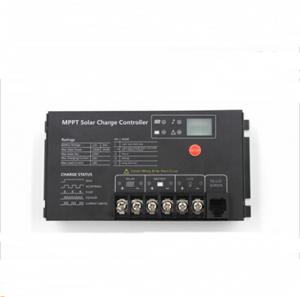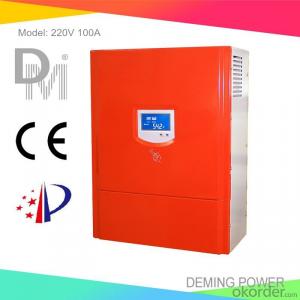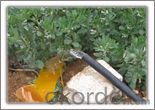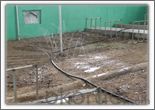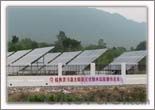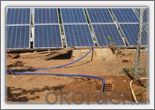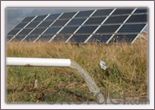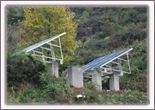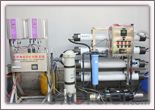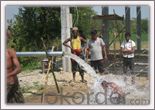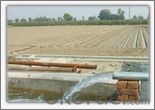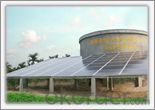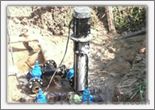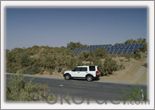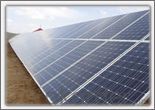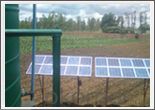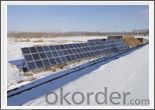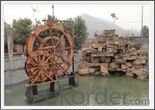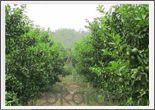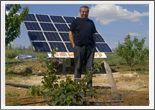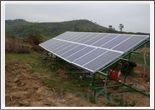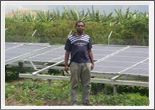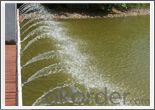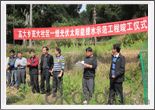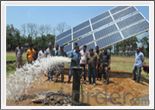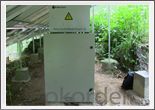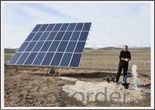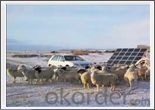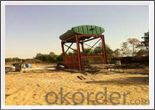DC Solar Water Pump Controller, Pumping System
- Loading Port:
- Shekou
- Payment Terms:
- TT OR LC
- Min Order Qty:
- 20 set
- Supply Capability:
- 100000 set/month
OKorder Service Pledge
OKorder Financial Service
You Might Also Like
Products
Solar Inverter Introduction:
Solar pumping inverter converts DC current from the solar array into AC current to drive the pump. With the function of MPPT (maximum power point tracking), it regulates the output frequency according to irradiation in real time to achieve the maximum power.
Solar Inverters Features:
1. Adopting the proposed dynamic VI maximum power point tracking (MPPT) control method; Fast response and stable operation; Better than the conventional methods which may lead to the problems including poor tracking performances, unstable or even cause water hammer damaging when the irradiation on the array changes rapidly.
2. The solar pumping inverters system is dispensed with energy storing devices, and stores water instead of electricity. It improves the reliability of the device, at the same time, it lowers the construction and maintenance costs of the system dramatically.
3. Digital control; automatic operation and data acquisition/storage of 8 years, etc; 98% of conversion efficiency, and complete protection.
4. In-line blocks; user friendly; convenient for operating; perfect cooling and shielding.
Technical Featrues
Solar Pumping Inverter Advantages:
1. To drive pumps equipped with 3-phase induction motors.
2. Optimized SPWM.
3. Various operation modes and MPPT algorithms are available.
4. Adjustable speed range of pump based on the actual situation of the system.
5. Available option of water-level detecting and control circuit.
6. Protection functions: lightning, over/low input voltage, over current and over load protection, etc.
7. Enclosure class: IP52.
8. Ambient temperature:-10~+50˚C.
Success Stories
►Middle East ►NaQu ►GuiLin
►Turkey ►XiNing ►YunNan
►Army stationed island ►Bangladesh ►Pakistan
►HaiNan ►HuBei ►Uganda
►XinJiang ►NingXia ►Afghan
►Zimbabwe ►Inner Mongolia ►Zhejiang
►Guangxi Guilin ►Turkey2 ►Botswana
►Naning ►Uganda ►Shaanxi
►Tsinghua University ►Pakistan ►Yunnan2
►FuJian ►Banqladesh ►YunNan3
►Turkey ►Inner Mongolia ►Senegal
Product Specifications
Model | Maximum input dc voltage | Recommended MPP Voltage | Rated Output Current | Output Voltage | Output Frequency | Net Weight | Gross Weight | Package Size | ||
Length | Width | Height | ||||||||
PB400L | 450 | 280-350 | 3 | 3PH 220V | 0-50 | 3.4 | 4.9 | 320 | 280 | 225 |
PB750L | 450 | 280-350 | 5 | 3PH 220V | 0-50 | 3.4 | 4.9 | 320 | 280 | 225 |
PF750L | 450 | 150-350 | 5 | 3PH 220V | 0-60 | 6.1 | 7.1 | 425 | 325 | 250 |
PB1500L | 450 | 280-350 | 7 | 3PH 220V | 0-50 | 4.0 | 5.6 | 355 | 280 | 225 |
PF1500L | 450 | 150-350 | 7 | 3PH 220V | 0-60 | 7.5 | 8.5 | 425 | 325 | 285 |
PB2200L | 450 | 280-350 | 11 | 3PH 220V | 0-50 | 4.0 | 5.6 | 355 | 280 | 225 |
PF2200L | 450 | 150-350 | 11 | 3PH 220V | 0-60 | 7.9 | 9.0 | 425 | 325 | 285 |
PB3700LA | 450 | 280-350 | 17 | 3PH 220V | 0-50 | 7.2 | 9.5 | 425 | 325 | 285 |
PB5500LA | 450 | 280-350 | 25 | 3PH 220V | 0-50 | 7.3 | 9.6 | 425 | 325 | 285 |
PB3700H | 750 | 500-600 | 9 | 3PH 380V | 0-50 | 7.2 | 9.5 | 425 | 325 | 285 |
PB5500H | 750 | 500-600 | 13 | 3PH 380V | 0-50 | 7.3 | 9.6 | 425 | 325 | 285 |
PB7500H | 750 | 500-600 | 18 | 3PH 380V | 0-50 | 7.7 | 10 | 425 | 325 | 285 |
PB11KH | 750 | 500-600 | 24 | 3PH 380V | 0-50 | 8.2 | 10.5 | 425 | 325 | 285 |
PB15KH | 750 | 500-600 | 30 | 3PH 380V | 0-50 | 8.4 | 10.7 | 425 | 325 | 285 |
PB18KH | 750 | 500-600 | 39 | 3PH 380V | 0-50 | 8.4 | 10.7 | 425 | 325 | 285 |
PB22KH | 750 | 500-600 | 45 | 3PH 380V | 0-50 | 18 | 21 | 600 | 465 | 350 |
PB30KH | 750 | 500-600 | 60 | 3PH 380V | 0-50 | 18 | 21 | 600 | 465 | 350 |
PB37KH | 750 | 500-600 | 75 | 3PH 380V | 0-50 | 20 | 23 | 600 | 465 | 350 |
PB45KH | 750 | 500-600 | 91 | 3PH 380V | 0-50 | 20 | 23 | 600 | 465 | 350 |
PB55KH | 750 | 500-600 | 112 | 3PH 380V | 0-50 | 20 | 23 | 600 | 465 | 350 |
- Q:How does a solar controller handle lightning protection?
- A solar controller typically includes built-in lightning protection mechanisms to safeguard the system from potential damage caused by lightning strikes. These protection measures are necessary because a lightning strike can introduce a massive surge of electrical energy into the system, which can potentially destroy the solar controller and other connected devices. To handle lightning protection, a solar controller employs various techniques. One common method is the inclusion of surge protection devices (SPDs) or lightning arrestors. These devices are designed to divert the surge of electrical energy from the lightning strike away from the sensitive components of the solar controller. SPDs typically use metal oxide varistors (MOVs) or gas discharge tubes (GDTs) to absorb and redirect the excess voltage to ground, preventing it from reaching the controller. Additionally, the solar controller may incorporate shielding or grounding techniques to further protect against lightning. Shielding involves enclosing the sensitive components in a conductive material, such as metal, to create a Faraday cage effect. This shielding helps to block or minimize the impact of electromagnetic interference caused by lightning strikes. Grounding, on the other hand, involves connecting the solar controller's metal components to a grounding system. This helps to provide a safe path for the lightning energy to dissipate harmlessly into the ground, rather than passing through the controller. It is important to note that while a solar controller's built-in lightning protection measures can significantly reduce the risk of damage, they do not provide 100% guarantee against lightning strikes. In areas prone to frequent lightning activity, additional external lightning protection systems, such as lightning rods or lightning arrestor systems, may be necessary to further enhance the protection of the entire solar power system.
- Q:Can a solar controller be used with a solar tracker?
- Yes, a solar controller can be used with a solar tracker. A solar controller is responsible for regulating the charging and discharging of batteries in a solar power system, while a solar tracker helps to maximize the efficiency of solar panels by following the sun's movement. By integrating a solar controller with a solar tracker, the system can effectively manage the power generated by the solar panels, ensuring optimal performance and battery charging.
- Q:What is the temperature rating of a solar controller?
- The temperature rating of a solar controller typically refers to the maximum and minimum temperatures at which the controller is designed to operate efficiently and effectively. The temperature rating will vary depending on the specific model and manufacturer, but in general, most solar controllers have a temperature rating between -20°C to 55°C (-4°F to 131°F). It is important to consider this temperature rating when selecting a solar controller for your system, as operating outside of the recommended temperature range can potentially lead to reduced performance or even damage to the controller.
- Q:Can a solar controller be used with a solar-powered greenhouse?
- Yes, a solar controller can be used with a solar-powered greenhouse. A solar controller helps regulate and optimize the usage of solar energy in a system. In a solar-powered greenhouse, the controller can control various components such as ventilation fans, temperature sensors, and irrigation systems, ensuring efficient use of solar energy and maintaining optimal growing conditions inside the greenhouse.
- Q:Can a solar controller be used with solar panel cleaning robots?
- Yes, a solar controller can be used with solar panel cleaning robots. A solar controller is used to regulate the charging and discharging of batteries in a solar power system. It ensures that the batteries are charged efficiently and protects them from overcharging or discharging. Solar panel cleaning robots can be integrated into a solar power system and benefit from the use of a solar controller to manage the power supply to the robot's batteries.
- Q:Can a solar controller be used with a solar-powered air conditioner?
- Yes, a solar controller can be used with a solar-powered air conditioner. A solar controller helps regulate the flow of electricity from the solar panels to the air conditioner, ensuring optimal performance and efficiency. It helps manage the charging and discharging of batteries, controls voltage levels, and protects the system from overcharging or discharging. By using a solar controller, the solar-powered air conditioner can effectively harness solar energy and operate seamlessly.
- Q:What is the maximum number of solar panels that a solar controller can handle?
- The number of solar panels that a solar controller can handle depends on the controller's specifications and capabilities. Typically, the capacity of a solar controller is determined by its maximum input voltage and current rating. Solar panels generate direct current (DC) electricity, and the solar controller's role is to regulate and optimize the flow of this DC power. This is done in order to charge a battery bank or supply power to an electrical load. The controller must be able to handle the voltage and current produced by the solar panels without surpassing its own limitations. To determine the maximum number of solar panels that a controller can handle, it is necessary to consider the voltage and current ratings of the panels and compare them to the specifications of the controller. By dividing the maximum input voltage and current rating of the controller by the corresponding values of the solar panels, one can estimate the maximum number of panels that can be safely connected. It is crucial to note that surpassing the maximum capacity of a solar controller can result in performance issues, such as reduced efficiency, overheating, or even damage to the controller. Therefore, it is essential to carefully examine the specifications of the controller and ensure that the total voltage and current of the connected solar panels are within its limits. This is necessary for reliable and safe operation.
- Q:How does a solar controller handle battery equalization charging?
- A solar controller handles battery equalization charging by monitoring the voltage levels of each individual battery within a bank. When the controller detects that the batteries have become imbalanced, it initiates an equalization charging process. This involves delivering a controlled amount of higher voltage to the batteries in order to restore their balance. The solar controller ensures that the equalization charging process is done safely and efficiently, preventing overcharging or damaging the batteries.
- Q:The principle of solar controller
- Solar controller uses high-speed CPU microprocessor and high-precision A / D analog-to-digital converter, is a computer data acquisition and monitoring and control system. It can collect the working data of the PV station in real time, obtain the working information of the PV station at any time, and accumulate the historical data of the PV station in detail, and provide the accurate and reliable evaluation of the reliability of the PV system design and the reliability of the quality of the inspection system Full basis. In addition, the solar controller also has a serial communication data transmission function, can be a number of photovoltaic systems sub-station for centralized management and remote control.
- Q:Can a solar controller handle different battery types (e.g., lead-acid, lithium)?
- Yes, a solar controller can handle different battery types such as lead-acid and lithium. However, it is important to note that not all solar controllers are designed to support all battery types. Different battery chemistries require specific charging algorithms and voltage settings. Therefore, it is crucial to choose a solar controller that is compatible with the specific battery type you intend to use.
1. Manufacturer Overview |
|
|---|---|
| Location | |
| Year Established | |
| Annual Output Value | |
| Main Markets | |
| Company Certifications | |
2. Manufacturer Certificates |
|
|---|---|
| a) Certification Name | |
| Range | |
| Reference | |
| Validity Period | |
3. Manufacturer Capability |
|
|---|---|
| a)Trade Capacity | |
| Nearest Port | |
| Export Percentage | |
| No.of Employees in Trade Department | |
| Language Spoken: | |
| b)Factory Information | |
| Factory Size: | |
| No. of Production Lines | |
| Contract Manufacturing | |
| Product Price Range | |
Send your message to us
DC Solar Water Pump Controller, Pumping System
- Loading Port:
- Shekou
- Payment Terms:
- TT OR LC
- Min Order Qty:
- 20 set
- Supply Capability:
- 100000 set/month
OKorder Service Pledge
OKorder Financial Service
Similar products
New products
Hot products
Hot Searches
Related keywords











